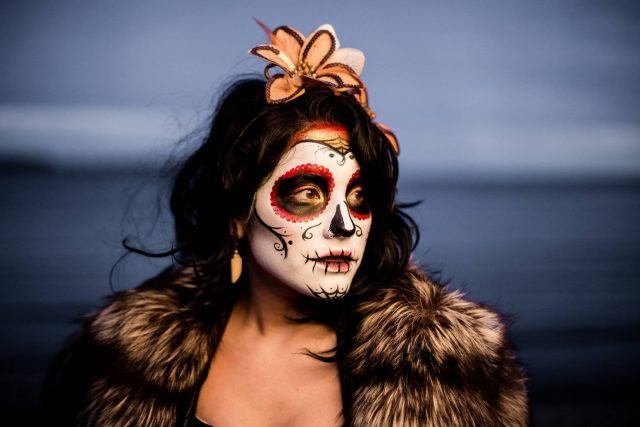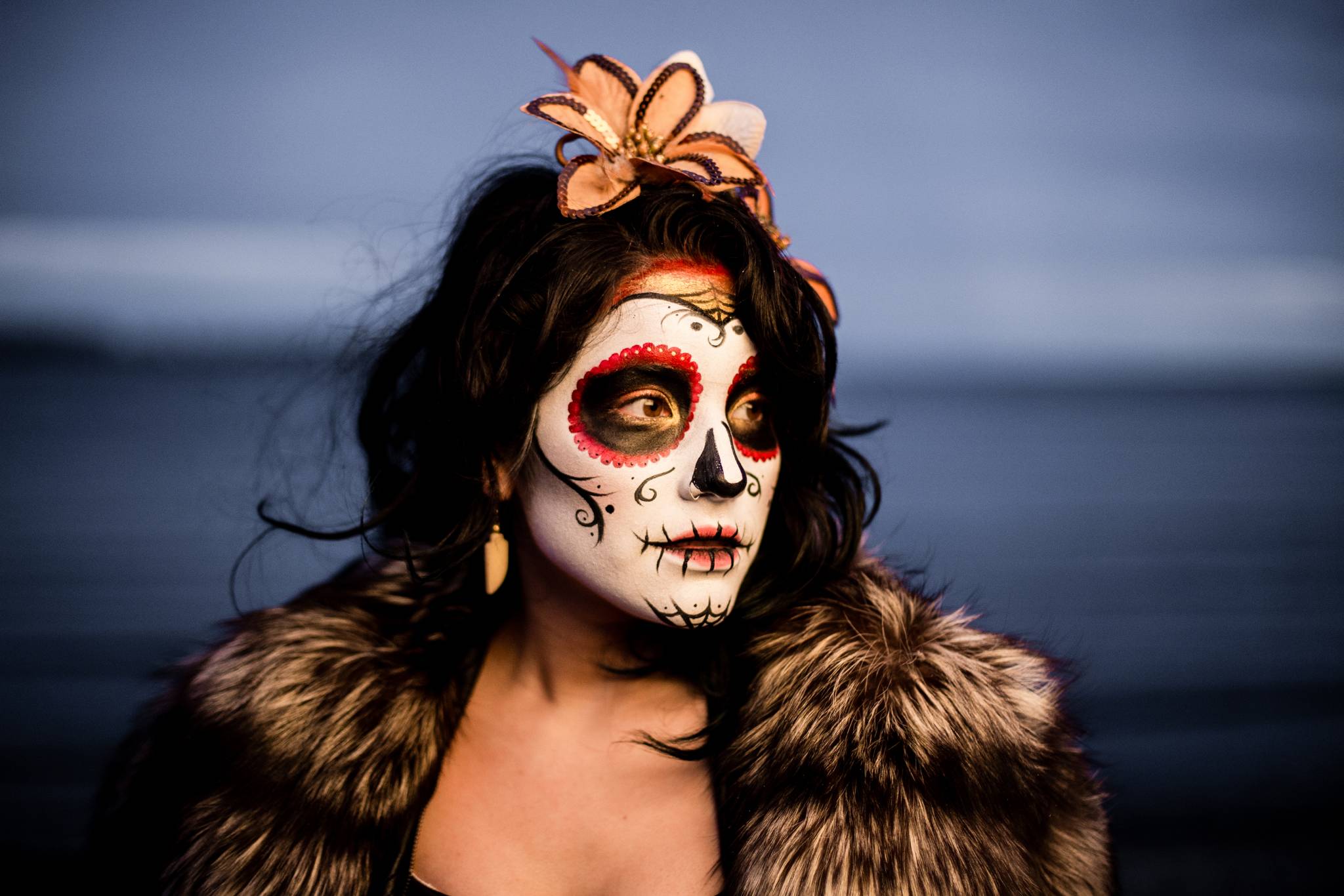Why spend the Day of the Dead in Mexico?
While the Day of the Dead is mostly a private family occasion, there is still plenty to observe and participate in for the general public. You’ll find busy markets, colorful decorations, elaborate altars, sand tapestries, costumed processions, and cemetery gatherings, as well as food, drink, and numerous local traditions that vary depending on where you go. And although it’s punctuated with quiet, somber moments, the holiday is actually a festive occasion, a celebration of life rather than death. For most westerners this is a truly life-altering experience.

Man dressed with traditional mexican folk costumes, photo by Marcos Castillo

Day of the dead parade in Mexico, photo by Dina Julayeva
Why do it now?
While the tradition of the Day of the Dead is still going strong, we feel that it might be on the verge of commercialization and at risk of losing its authenticity. With movies like Spectre, The Book of Life, and Coco, the holiday is gaining mainstream appeal outside of Mexico and is increasingly becoming a tourist attraction. And when this happens, it’s only a matter of time before the market does its thing. So our advice is to act quickly and discover the true spirit of this tradition before it’s lost for good.
When is it?
The Day of the Dead actually lasts for three days, from October 31 to November 2, with November 1 being the highlight of the holiday. Additionally, there is now a Day of the Dead parade in Mexico City the weekend before the Day of the Dead. So, an ideal itinerary might be to fly to Mexico City for the parade and then travel to a smaller city, preferably further south, for the holiday itself.
What’s the best destination?
While there are a number of worthwhile Day of the Dead destinations, we believe that Oaxaca has a well-balanced combination of strong tradition and adequate tourist infrastructure. Apart from the holiday, Oaxaca has established its tourist reputation through its food, culture, artisanship, and historic sites—all giving you plenty to do in-between main events.

Day of dead celebration on the streets of Oaxaca, photo by Eva Lepiz

A cemetery during Day of the Dead in Oaxaca, photo by Kobby Dagan

Traditional day of the dead altar with pan de muerto and candles, photo by AGCuesta
What are the key experiences?
The Day of the Dead is not just about the cemetery and the procession. The three-day holiday includes multiple stages of preparation and celebration happening over several locations. We believe that for an immersive experience it’s a good idea to try to observe as many of them as you can.
Local markets
There is no skimping on decorations when it comes to building the Day of the Dead altar, and the local markets are more than happy to deliver. Feast your eyes on marigolds (cempasúchil), candles, incense, bread (pan de muerto), skeleton decorations (calacas), and sugar skulls, and the list goes on. While you probably won’t need to buy any of the items for yourself, observing the Christmas-like shopping frenzy is a good way to get into the spirit of things. Walk the stalls or grab a snack, sit back, and enjoy some people-watching.
Oaxaca markets: Mercado 20 de Noviembre, Central de Abastos Market, Mercado Benito Juárez, Mercado La Merced.
Sand tapestries
A tradition specific to Oaxaca is the construction of sand tapestries, which are normally made for burials but become a display of creative skill during the Day of the Dead. Tapestries are sculpted from sand and painted with vibrant colors, usually depicting religious and death-related imagery. You’ll have no problem finding plenty of them around—the entire city becomes an art gallery.
Places to see sand tapestries in Oaxaca: the Museo del Palacio, Calle Macedonio Alcalá Street, the Casa de la Cultura, and the main square.
Altars
While most of the altars (ofrendas) are constructed at home, there are also multiple public altars around the city and inside the cemeteries. As is with the sand tapestries, schools and organizations hold friendly competitions for the best altar in town, creating elaborate displays with endless detail and color.
Cemeteries
The highlight of the holiday is when families gather at the cemetery and the souls of the dead come to visit. This is the time for candles, snacks and drinks, and telling anecdotes from the lives of those who passed away. Tourists may walk about and observe, but you should probably put your camera away and avoid disturbing the families unless invited to join.
Cemeteries in Oaxaca and nearby: San Miguel Cemetery in Oaxaca, Nuevo Cemetery in Xoxocotlán, the cemetery in Atzompa, and the cemetery in San Antonino Castillo Velasco.
Processions
Though the purpose of the Day of the Dead procession differs throughout Mexico, it invariably features music, skulls, skeletons, and crazy costumes, most notably catrinas (lady skeletons wearing fancy hats), and small portions of mezcal (smoky, tequila-like alcohol). This is your chance to blend in and interact with the crowd and experience the holiday like a local. Grabbing a costume or painting your face will add to the fun.
Processions in or near Oaxaca: while the processions happen by themselves and may appear throughout the city, the city center of Oaxaca and San Agustin in the Elta Valley are guaranteed to produce a crowd.

Dia de los Muertos, photo by Anton_Ivanov

Participants in traditional clothing during Dia de los Muertos Mexican carnival, photo by Oleg Znamenskiy
What is the protocol?
Seeing how this is largely a private and religious occasion, we thought it useful to include a couple of tips on etiquette to follow while attending.
Taking photos. There is a clear line between private and public and, as a rule, you should refrain from taking pictures of the graves and private altars. At the very least, you should ask permission. It is fine to photograph public altars, tapestries, and decorations.
Touching altars. Neither tourists nor locals are allowed to touch anyone else’s altar – the rule is followed strictly by all.
Celebrating. As long as you respect the obvious boundaries, it’s perfectly ok to dress up, paint your face or wear a mask, visit the cemetery, have a picnic, drink alcohol, talk to families who invite you to share a meal with them, and be festive and enjoy yourself.
How to get to Oaxaca using miles
Currently, Delta offers the lowest fare of 35,000 miles for a round-trip flight from JFK to Oaxaca. The quickest way to earn that many Delta miles is to apply for an American Express credit card, earn the welcome bonus, and then convert Membership Rewards to Delta miles at a 1:1 rate.
If we had to suggest a specific card, we’d say that the Premier Rewards Gold Card is the best choice for the job. It offers a bonus of 50,000 points once you spend $2,000 on purchases, which is more than enough for this trip. The annual fee is $195, but it’s waived the first year and the card comes with additional benefits such as airline credit and bonus rates for dining, gas, groceries, and airline purchases.

Mariachis perform during the carnival of the Day of the Dead in Oaxaca, photo by Kobby Dagan

Mexican handicraft, photo by stacyarturogi
The bottom line
Even on a regular day there is plenty to keep you occupied in Oaxaca, which is often called one of the culinary capitals of Mexico. On the Day of the Dead, however, there is simply no other place to be. From shopping, to preparations, to creative displays, to celebrations, to food and drink, you’ll have the full range of local experiences and gain a unique insight into one of the world’s most mysterious holidays.





































